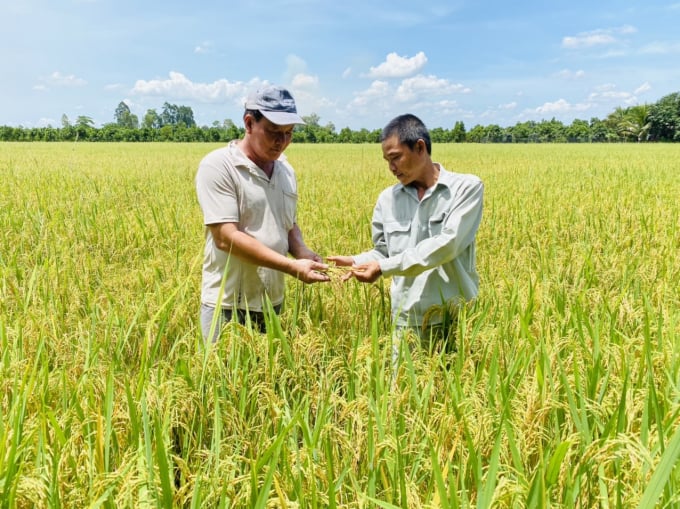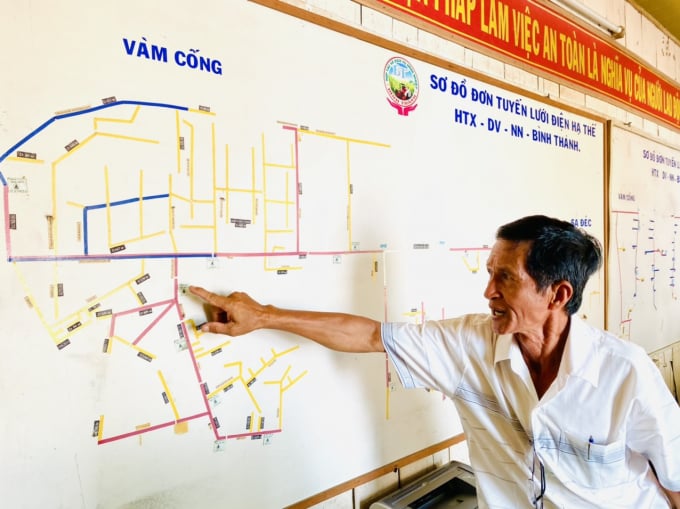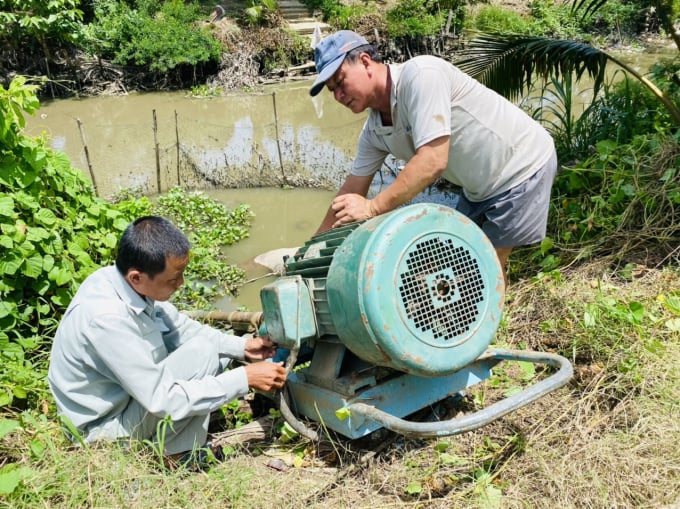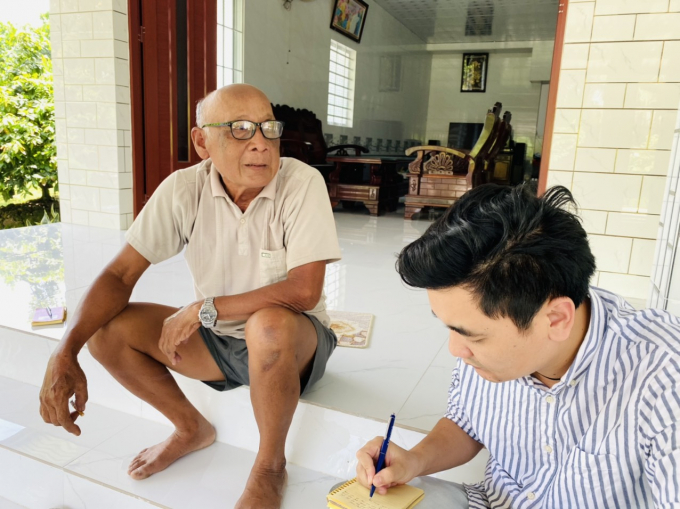May 30, 2025 | 17:50 GMT +7
May 30, 2025 | 17:50 GMT +7
Hotline: 0913.378.918
May 30, 2025 | 17:50 GMT +7
Hotline: 0913.378.918
Introduction:
After 20 years of implementing the Resolution of the 5th Central Committee - term IX on maintaining innovation, developing and improving the efficiency of collective economy, although many "bottlenecks" remain that need to be removed and cleared, the achievements of collective economy have proven that this is an inevitable and objective path of agriculture, farmers and countryside.
This series of articles are records that speak the truth of the fields in the Southwest region - the land considered to have the strongest transformation in the collective economy. These outstanding methods and models may have yet a set of national solutions, but their revolutionary effects are undeniable.
The land of Lap Vo, Dong Thap province is located along the Cai Tau Thuong canal connecting Tien and Hau rivers. And from the reality shown in this place, collective economy has truly turned farmers who are once used to getting their hands and feet wet in the fields of Thap Muoi into leisurely producers.

The collective economy has been turning farmers who are once used to getting their feet wet in the granaries of Thap Muoi into leisurely producers. Photo: Hoang Vu.
Like many other granaries in the West, Lap Vo is only full of old farmers now. But do not rush into thinking that this is an arduous and extreme work situation. Mechanization over the years has brought machines to the fields and basically liberated farmers' labor.
As evidence of that fact, it is currently the peak period of the summer-autumn rice harvest, but the number of workers in the hundreds-thousand-ha fields can only be counted on the fingers of one hand. And it is not just in the reaping stage. From tilling, sowing, pumping, watering to spraying, fertilizing are now all done by machines.

Director of Binh Thanh Cooperative Nguyen Van Doi. Photo: Hoang Vu.
Let’s take elder farmer Vo Van Phen (69 years old) for example. His family has a 1.2 ha field in Binh Phu Quoi hamlet. Plus the area leased by his two sons regularly doing three crops a year, if there are no unusual events, a profit of hundreds of millions of dong is possible.
“Every 1,000 m2 normally costs from VND 1.7 to 1.8 million per crop. This year, the price of fertilizer is high, so it's approximately VND 2.5 million. more than 800 kg of rice can be obtained, and the profit is estimated at over VND 1.2 million. If we do the math, farming only takes a few days a year at most. As for who works the land, who pumps water, who takes care of the crop and then sells it, I don’t really need to know. All have been taken care of by the cooperative,” said Phen.
It is no exaggeration to say that collective economic thinking has changed the lives of Lap Vo people. Every household in Binh Thanh commune with a field joins the cooperative. Even farmers in many other places come to join Binh Thanh Cooperative. Some people call it a "7 communes 4 provinces cooperative" because among 1,814 member households, apart from farmers in 7 communes in the district, there are relatives from Vinh Long, Can Tho, Dong Thap, and An Giang. Not a single member of the cooperative is considered a poor household.

Binh Thanh is the cooperative with the most services to directly serve member households. Photo: Hoang Vu.
“The cooperative model is different from enterprises in a sense that it must put benefits before profits. We will do whatever is beneficial for the cooperative members, even when it’s not profitable, we will take one thing to make up for the other. For example, out of 13 services the cooperative is doing, most of them are more or less profitable, but there are three services that pile up economical losses the more we do, which are agricultural extension, plant protection and rice consumption services. The cooperatives have to spend money to hire experts to train, provide knowledge and support farmers, hire inspectors to take care of the fields, and purchase machinery as well as equipment for rice drying and storage. That is to make people find it beneficial to join a cooperative," said Nguyen Van Doi, Director of Binh Thanh Cooperative.
In 1989, during a great upheaval in the cooperative economy, a series of localities announced the dissolution of the agricultural production group model after Directive 47-CT/TW of the Secretariat to solve a number of urgent problems concerning arable land. Binh Thanh Cooperative was established in that context.

“Having decided to take on the path of collective economy means difficulties are bound to exist. If we do not explore, create, and are not consistent, success will forever remain a dream,” said the Director of Binh Thanh Cooperative. Photo: Hoang Vu.
That was because despite complicated issues specifically land disputes, both farmers and people working in Binh Thanh agricultural production group at that time realized there was only the path of collective economy could organize production methodically, bring into full play the potential advantages of the land, and eliminate fragmented mindset.
It was a decision that went against the policy, or at least that was what many leaders of Lap Vo district thought. So for half a year of operation, Binh Thanh Cooperative had no stamp anything. They kept building plans, organizing production, meeting cooperative members to start the crop, and mobilizing capital. The story then reached the leaders of Dong Thap province, and the management board of Binh Thanh Cooperative was demanded an explanation. He asked only one question: “What are the benefits of continuing collective economy?”
Both Secretary of the Party Tu Nhon and Director Doi at that time responded: You have to be a cooperative to be able to link production and fully utilize the infrastructure invested by the state.
After discussing all the pros and cons, the province saw that it was okay for the district to continue. A new phase of collective economy in Thap Muoi began. The operating principles were set out: “What the people cannot do, the cooperative will”. As a result, the cooperative worked smoothly and efficiently.
Whatever it was, as long as it benefited the members, the cooperative would do it. Cooperatives acted as an intermediary, signed "three-parties contracts", purchaseed and supported rice consumption for the people by helping them sell the crop to businesses. There were years when the losses were “as big as a mountain” but the profit lied in the fact that people could sell products.
The same went for rice seeding. The cooperative built 30 ha of rice seed production to supply members and contract with the people, and then calculate how to lower the market price so that people can see that the cooperative's services were different from those of other parties outside. If a seed-selling enterprise encountered a problem, they would blame the technology or the weather. That was not the case for the cooperative. If anything was wrong with the rice, people would surely complain.

The cooperative would do anything that benefitted the members. Photo: Hoang Vu.
“A cooperative without people’s complaints is not a cooperative. We have this standpoint: we have to listen no matter what. Because we are offering service, so if the complaint is right, we correct it. If it’s wrong, we would give the members some explanation. Everything must be clear and just. Thanks to that, after some time I don't see the members complaining anything, so I actually miss it a little," said Director Doi with a laugh.
Binh Thanh today is a newly improved rural commune, in which the cooperative’s merit is by no means small. Head of Lap Vo district’s Department of Agriculture and Rural Development Ho Tan Vu said, “Together with 16 agricultural cooperatives in the district, although there is still much work to be done, the role of collective economy in organizing production, linking agro-product consumption, offering daily life services for cooperative members and building a new countryside is commendable.”
In order to ensure the commune's improved new rural criteria, Binh Thanh Cooperative has taken responsibility for three criteria including electricity - irrigation - natural disaster prevention, production organization and agricultural economic development. The cooperative also supports communes in many other criteria.
It is also rare to see a cooperative to have full of Party members operating for nearly 20 years, a grassroots-level trade union, a study promotion association, a youth union, and a farmer association. The cooperative's director is the deputy head of the natural disaster control department and at the same time the deputy head of the new rural construction department, contributing greatly to the change of face in Binh Thanh’s countryside.

Director Nguyen Van Doi. Photo: Hoang Vu.
Of course, there are still many difficulties and obstacles such as policy mechanisms. In recent years, there are many policies to support cooperatives in particular and collective economy in general, but getting access to its benefits is not easy. Trying to meet the conditions is already hard, and when it’s enough, difficulties still appear to exist. It is because mechanism and policy are from the government, but the resources are of the locality, leading to difficulties in allocating. The policy must be of the same level in order to allocate those resources.
There are also tax or credit policies that are still difficult to access, but perhaps the Party and State will gradually remove them. The main thing is to identify the path: "cooperative, cooperative and only cooperative". People's mindset about collective economy is experiencing vivid changes.
Translated by Samuel Pham

(VAN) Several scientists and farmers are experimenting with soil treatment in some key durian-growing regions such as Cai Lay (Tien Giang), Dak Song, Gia Nghia, and Dak R’lap (Dak Nong).
/2025/05/25/4127-3-073637_820.jpg)
(VAN) Thanks to the promotion from an FAO-implemented project, vegetable production in greenhouses in Moc Chau has seen strong development, from 1.5 hectares in 2021 to nearly 50 hectares in 2024.

(VAN) FAO has recently supported USD 140,000 to implement the project 'Risk mitigation human-animal interface risks through disease control initiatives in pig farming.'

(VAN) The People's Committee of Tra Vinh province has approved an adjustment to the investment policy for the Green Hydrogen Plant project, increasing its area to approximately 52.76 hectares.
![Reducing emissions from rice fields: [2] Farmers’ commitment to the soil](https://t.ex-cdn.com/nongnghiepmoitruong.vn/608w/files/news/2025/05/05/dsc08881jpg-nongnghiep-140632.jpg)
(VAN) Clean rice cultivation model in Thuong Tan commune, Bac Tan Uyen district, is assisting local residents in achieving sustainable agriculture by substantially reducing costs, increasing productivity, and protecting the environment.

(VAN) At the conference to disseminate Resolution No. 68, AgriS introduced its digital agricultural ecosystem and reaffirmed its commitment to accompanying the Government in promoting private sector development and sustainable agriculture.

(VAN) 'Blue Ocean - Blue Foods' initiative is designed to restore marine ecosystems and establish sustainable livelihoods for local communities by cultivating a minimum of 1,000 hectares of cottonii seaweed in the first three years.